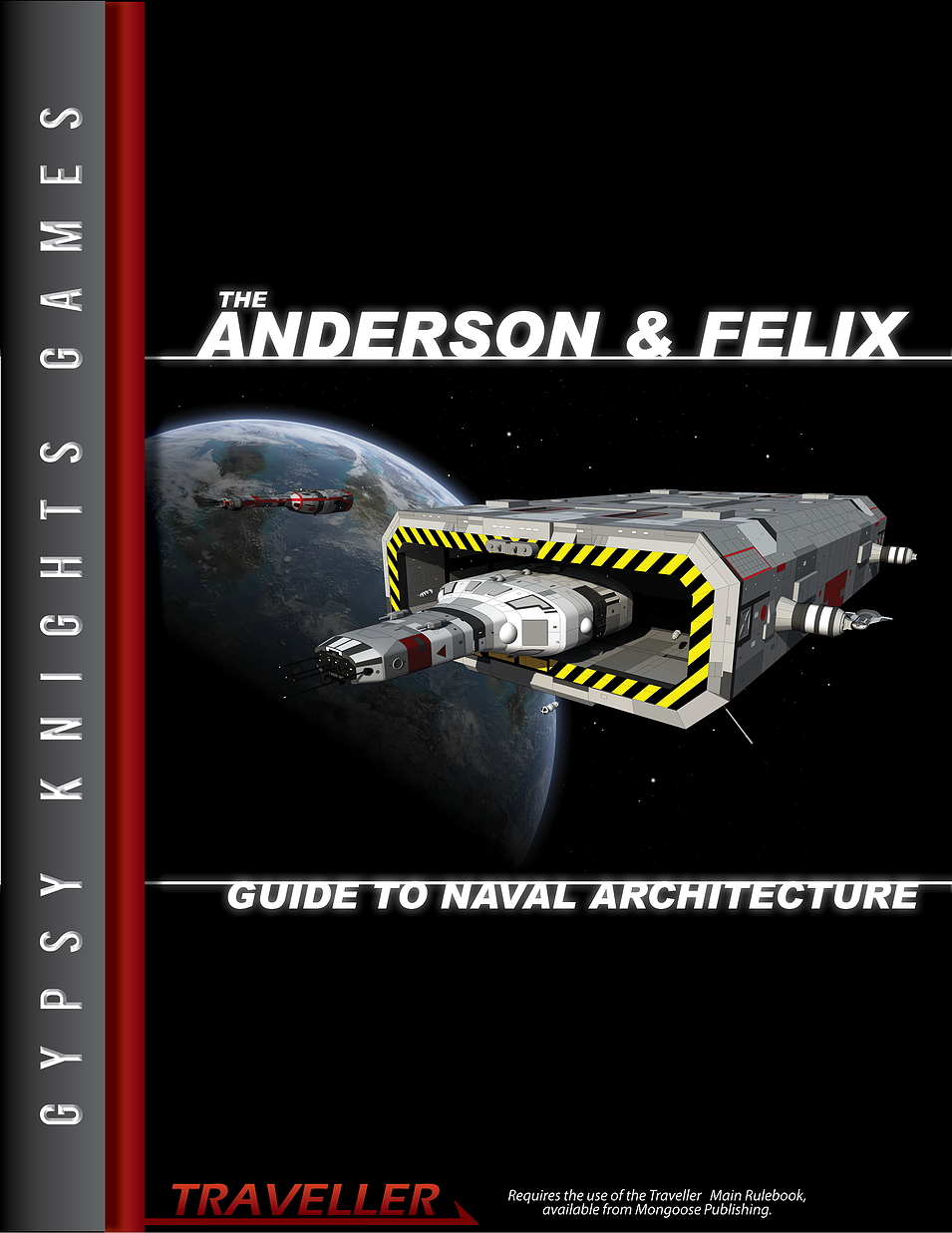The Anderson & Felix Guide to Naval Architecture
This review originally appeared on rpg.net in October 2015, and was reprinted in the May/June 2016 issue.
 The
Anderson & Felix Guide to Naval Architecture. Michael Johnson.
The
Anderson & Felix Guide to Naval Architecture. Michael Johnson.
Gypsy Knights Games. http://www.gypsyknightsgames.com
114pp., PDF, Softcover, or both Bundled
US$19.99(S,B)9.99(P)/UKú13.88(S,B)6.94(P)
There are a subset of Traveller players (in Traveller’s case, they are known as gearheads), and possibly all of RPG players that pride themselves, in building things. Whether it is building scale model dungeons in their basements or building starships from Lego™ to hang in their hobby rooms or designing unique minis and getting printed via 3D printers. I am not one of those players. I am a Gamemaster and a player who favours free-flowing narrative, who wishes that dice rolls could be called as part the overall dialogue rather doing a shout out. So, when I get something like this item, it is very hard to review objectively, as it is a manual on how to build starships in the Clement Sector ATU. Like (or, more accurately, complementing), Mongoose’s Book 2: High Guard, there is essentially a number of components that have to be fitted from different charts to build a starship.
The rules and construction techniques are very solidly grounded in years of Traveller construction techniques that date from the 1970s. And therein lies my problem; these rules do not expand the imagination. When I was young, I could be intrigued by Black Globes or Particle Accelerators or Fusion Guns (Black Globes or similar Force Shields do not appear in this volume as they are too high tech), but at the same time, I do not want completely fantastical weapons. So this book does its job; it is a workshop for building starships, not the imagination. So, there is little for people who are narrativists, aside from the occasional piece of purple prose and fantastic illustrations.
Overall, I cannot think how this work can really be improved, except to break the limitations of what the ATU has established as the overall tech level. There is a precedent in Traveller for doing this—TNE’s Fire, Fusion & Steel—which once again harvested the imagination of different SF tropes and…yes…it was incredibly buggy and the sums did not add up. But, folks, we are talking about building Starships here; there has to be an element of the imagination inserted in. And, beyond simple engineering, there has to build in a sense of wonder. Perhaps it is the drawback of all SFRPGs that when players want to add-on chrome fittings, one needs a Sourcebook like this one, otherwise they end up with Vogon Constructor ships. And, abstractly, if one takes a look at Traveller, much of the art (with some notable exceptions) has been about creating Vogon ships. It is an irony, as the conceptual art that is going into the SF genre, whether on the big screen or the small, is radically improving thanks to CGI, that this has not translated into some sort of shift in the art of starships. One must remember Steve Jobs’ quip about Bill Gates; he could forgive for all he stole from Apple, save one:
“…Why did he have to make it so ugly looking…”
That is how I feel about this product. There is much potential residing within these pages, and for the gearhead audience I am sure it is a godsend. I am thus reluctant to give this a bad rating, because it is a fine product in its own right, but at the same time it is not what I have come to expect from GKG. GKG has been steadily advancing away from the Tables and Charts model of early Traveller toward more of a narrativist freeform model using charts to illustrate the story rather than be the story. This product represents a side step away from that. Fantastic art, even if it is poser art (CGI), makes this a stunning product to leaf through. However, at the end of all these Tables and Charts, one does wish that Traveller could come up with a basic sketch program that would translate what are essentially spreadsheet statistics into something beautiful once again.
 Freelance
Traveller
Freelance
Traveller